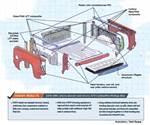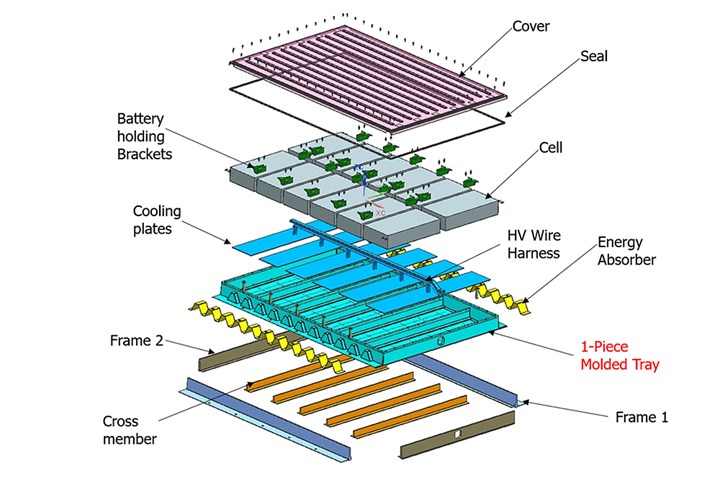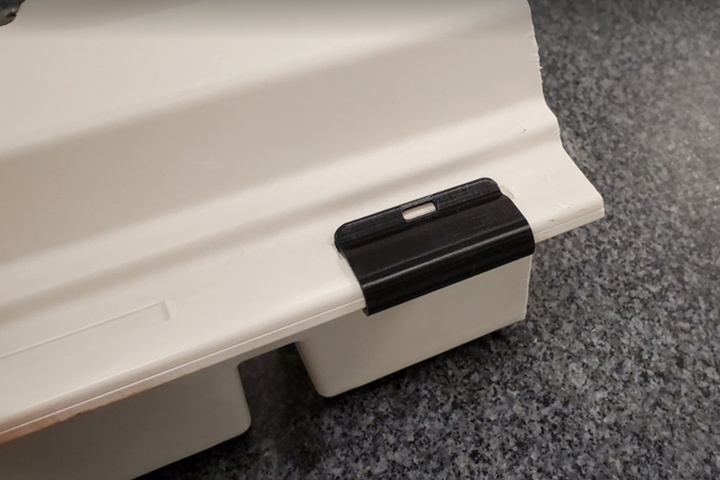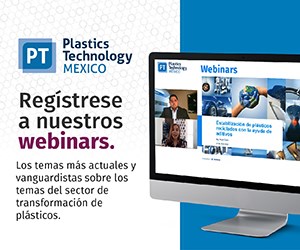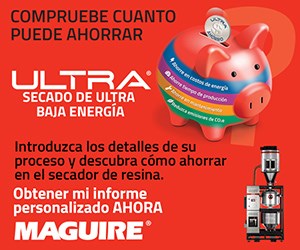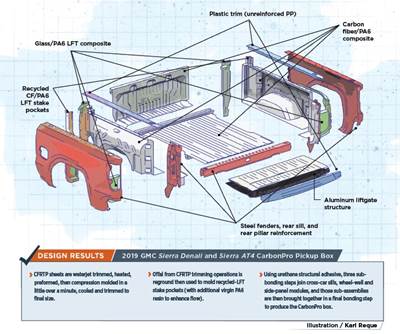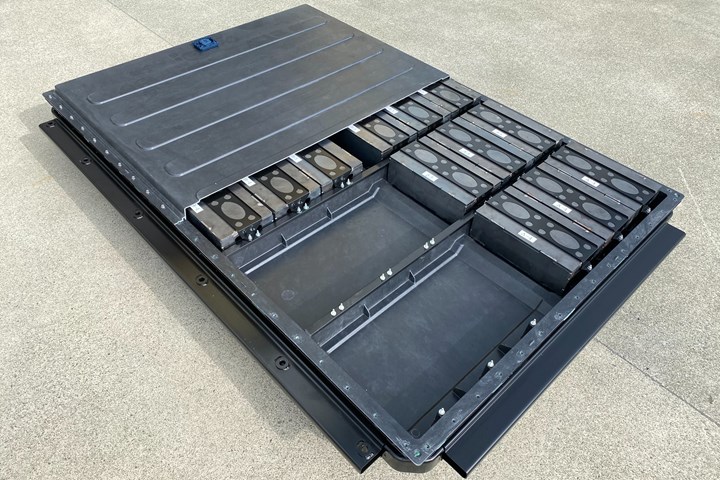
Continental Structural Plastics (CSP) has been designing and manufacturing composite battery covers since 2012. Recently, the company has expanded its portfolio to include full battery enclosures. Photo Credit, all images: CSP
As automotive OEMs focus on transitioning to a market of all-electric vehicles in the near future (by 2035, for General Motors), electric vehicle (EV) components will need to be produced at higher volumes. In the composites world, the relatively lighter weight, higher strength and thermal resistance properties of many composite materials make them an increasingly attractive alternative to metal for EV battery covers in particular, and CW continues to learn about new efforts to design more efficient, lighter-weight composite battery covers (see recent examples from an Evonik-led consortium and TRB Lightweight Structures).
Continental Structural Plastics (CSP, Auburn Hills, Mich., U.S.) has been supplying compression-molded composite EV battery covers for almost a decade, since the company first began supplying upper and lower battery boxes for the Chevrolet Spark in 2012. Since then, the company’s battery covers have ramped up in popularity, and also in size — current covers may be 1.5 by 2 meters or larger. “Battery boxes are definitely one of our main focuses now, since we have more than 30 different covers in production currently,” says Hugh Foran, executive director at CSP. He predicts that battery electric vehicles (BEV) will be a focus for automakers for the next ten years or more, even as technologies for hydrogen fuel cells also ramp up.
Foran says that one of the biggest issues OEMs report having with metal battery boxes, and why they come to companies like CSP to explore composite options, is leakage: “Believe it or not, they can make submarines that go to the bottom of the ocean that don’t leak, but apparently there are issues making metal battery boxes that don’t leak.”
Within the past two years, CSP and parent company Teijin Ltd. (Tokyo, Japan) have begun to focus on developing full, multi-material battery enclosures in addition to supplying the upper covers and lower trays. “As one of the initial programs at our new Advanced Technologies Center [Auburn Hills], we designed and built the molding tools with production mold steel (P-20), and then we started formulating different materials and distinctive processes to enhance not just the molds but the parts themselves,” Foran says. “We’ve been doing extensive testing. We have our own crash testing at GH Craft in Japan, so we’ve evaluated the different frames and have modified the box design somewhat, including adding some more ribbing to add more structure.” CSP has also worked with its suppliers on different preforms and fiberglass materials to add into the boxes, as well as battery suppliers to be able to test the full enclosure for thermal runaway requirements and evaluation under load.
CSP’s multi-material battery enclosure demonstrator showcases the company’s ability to produce all components needed for a battery enclosure, including assembly, in a variety of materials per customer requirements.
In December 2020, CSP and Teijin unveiled a full-scale demonstrator of its multi-material EV battery enclosure, for which the company was announced as a finalist for the 2021 Automotive News PACE pilot award. Foran says that CSP is also currently working with four OEMs on designs for full battery enclosures.
Multi-material options for a lighter-weight enclosure
One purpose in building the demonstrator of an entire battery enclosure, Foran says, was to explore new technology options to share with customers, including use of different materials, and covers molded at different thicknesses and shapes depending on application requirements.
In addition to the battery, the enclosure itself comprises at least three structural components: a relatively thin composite top cover, a thicker and more structural composite bottom tray and a metallic ladder-shaped frame to provide additional support for the batteries within the box’s interior. For reference, the majority of weight of a battery back is the batteries themselves, which can weigh up to 1,000 pounds. CSP has also developed an energy-absorbing structural foam interior frame that can be used for higher crash impact protection.

The top and bottom trays are manufactured as one-piece, compression-molded composite components with all features molded in.
The top cover and bottom tray components are compression molded with CSP’s 4,000-ton press. For ease of assembly, CSP has designed both components to be one-piece structures, with all features molded in. No sealants or through-holes are required for fastening.
Currently, CSP has developed five composite material systems for use in its top covers and bottom trays: fire-resistant ATH used within a traditional sheet molding compound (SMC), an intumescent system for higher flammability requirements, phenolic, as well as 834E vinyl ester and snap-cure resins for use with woven materials and resin transfer molding (RTM). Different amounts of glass fiber are added to the resins per application requirements. Carbon fiber and other fiber types can also be used, Foran says, though most customers choose glass fiber as a less expensive option, and because the glass also acts as an insulator and can help with fire resistance.
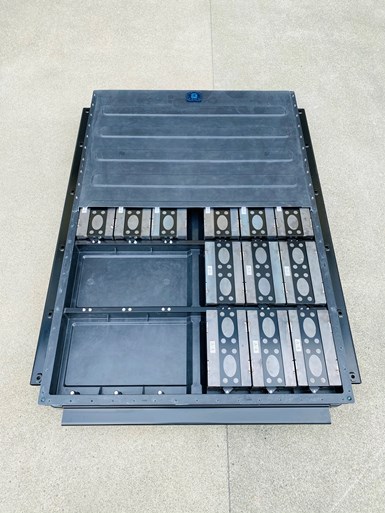
In addition to its full-scale demonstrator battery enclosure (pictured here), CSP is beginning to work with OEMs on designs for series production.
Foran notes that, depending on the application, different materials can be molded in or added after molding to add functionality such as EMI or RFI shielding to the battery box. Depending on the location of the battery and type of battery being used, thermal runaway of the batteries or particularly high fire resistance may be of higher importance. “We have multiple ways of solving each of these issues,” he says. “There’s so many different battery chemistries that are out there, from solid state batteries that are more expensive but don’t have any liquid in them, to highly combustible lithium-ion batteries, so it’s all about what the customer is using and what they want.”
Overall, CSP reports that its multi-material battery enclosure is about 15% lighter than a steel battery box, with better temperature resistance compared to aluminum.
Next-level innovations: Clips, impact shields, full-assembly capabilities
CSP continues to innovate its battery enclosure design, as well as its range of capabilities for customers. For example, to ease assembly and eliminate the machining of holes or the use of sealants to connect battery box top and bottom covers, CSP and Teijin Ltd. have also introduced a patent-pending clip system for connecting the top and bottom covers on battery boxes to replace mechanical bolting or welding. “Depending on the size, these covers can have up 70 holes in them for bolting, so this eliminates not only those holes but also spreads out the pressure load at the attachment point. And unlike welded boxes, this also enables the batteries to be serviceable,” Foran says.
A specially designed clip system aims to eliminate the use of sealants, welding or machined holes in composite battery boxes, and to ease serviceability of the batteries.
In addition, CSP has also been working on composite-based impact shields that can be positioned underneath the battery box for additional protection. Titanium impact systems are used in some cars currently, Foran notes, but they are looking at less expensive (recycled) aramids and other composite options and expect to be able to build a full-scale demonstrator for testing later this year.
Ultimately, Foran says that OEMs are looking to suppliers like CSP to not only supply battery covers, but to provide full battery units that meet all their quality and volume requirements. This has led to CSP developing its multi-material battery enclosure, and to its working directly with battery suppliers to assemble the full battery enclosures prior to shipment.
Foran adds, “Customers want us to leak test all of our covers, to build up the full battery packs, and then ship those into the assembly plants, completed. It makes sense: Shipping an empty box with all the components separately takes up more space in a shipping container or truck. This has become a key focus for us as well.”
Lea a continuación
Chopped carbon fiber, polyamide and innovation redefine the modern pickup truck bed
CarbonPro, the first thermoplastic composite box, boosts damage resistance, reduces mass 28 kg, scales to high production volumes.
Leer MásCambio de paradigma en la inyección de cubetas
StackTeck y Avance Industrial unieron su conocimiento técnico en moldeo por inyección para romper paradigmas en la fabricación de cubetas. Así, demostraron una poderosa combinación de tecnologías de molde, máquina y enfriamiento que les permitió llegar a un ciclo de producción de tan solo 13 segundos para cubetas estándar.
Leer MásClasificaciones de moldes de inyección de plásticos: análisis detallado
Examine los factores que influyen en la durabilidad de los moldes de inyección. Desde la complejidad del diseño hasta la selección de materiales, aprenda cómo optimizar la vida útil de los moldes.
Leer Más

.jpg;width=70;height=70;mode=crop)
